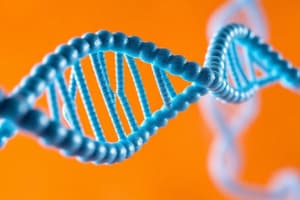Podcast
Questions and Answers
What is the outcome of the semiconservative mechanism of DNA replication?
What is the outcome of the semiconservative mechanism of DNA replication?
- Three new strands form from one original strand
- One strand is parental and one is newly synthesized (correct)
- Both strands are newly synthesized
- Both strands remain unchanged from the original
Which mechanism of DNA replication produces one double helix with both parental strands?
Which mechanism of DNA replication produces one double helix with both parental strands?
- Amplification
- Dispersive
- Conservative (correct)
- Semiconservative
During the Meselson and Stahl experiment, what type of DNA was initially used?
During the Meselson and Stahl experiment, what type of DNA was initially used?
- Both N14 and N15 DNA
- Only N14 DNA
- Only N15 DNA (correct)
- DNA from different organisms
What role does the enzyme DNA polymerase play in DNA replication?
What role does the enzyme DNA polymerase play in DNA replication?
What is the correct pairing of strands in DNA replication?
What is the correct pairing of strands in DNA replication?
Which of the following mechanisms produces DNA strands with segments of parental and new DNA?
Which of the following mechanisms produces DNA strands with segments of parental and new DNA?
What happens to the hydrogen bonds during the untwisting of the DNA molecule?
What happens to the hydrogen bonds during the untwisting of the DNA molecule?
Where are nucleotides added during DNA strand synthesis?
Where are nucleotides added during DNA strand synthesis?
What is the primary function of DNA ligase during DNA replication?
What is the primary function of DNA ligase during DNA replication?
Which protein is responsible for unwinding the DNA double helix?
Which protein is responsible for unwinding the DNA double helix?
What characterizes the semi-conservative nature of DNA replication?
What characterizes the semi-conservative nature of DNA replication?
During DNA replication in eukaryotic cells, how does the process initiate at the replication origin?
During DNA replication in eukaryotic cells, how does the process initiate at the replication origin?
What are Okazaki fragments associated with in DNA replication?
What are Okazaki fragments associated with in DNA replication?
Which enzyme is responsible for adding nucleotides to a growing DNA strand?
Which enzyme is responsible for adding nucleotides to a growing DNA strand?
Which of the following statements about DNA replication in bacteria is correct?
Which of the following statements about DNA replication in bacteria is correct?
What is the role of the sliding clamp during DNA replication?
What is the role of the sliding clamp during DNA replication?
What specifically occurs during the 'untwisting' of the DNA molecule?
What specifically occurs during the 'untwisting' of the DNA molecule?
Which mechanism of DNA replication results in two double helices, each with one parental and one new strand?
Which mechanism of DNA replication results in two double helices, each with one parental and one new strand?
In DNA replication, which direction are nucleotides always added to the new strand?
In DNA replication, which direction are nucleotides always added to the new strand?
Which of the following best describes the outcome of the Meselson and Stahl experiment?
Which of the following best describes the outcome of the Meselson and Stahl experiment?
Which strand orientation is observed during DNA replication?
Which strand orientation is observed during DNA replication?
What is a characteristic feature of the dispersive mechanism of DNA replication?
What is a characteristic feature of the dispersive mechanism of DNA replication?
During DNA replication, which enzyme is primarily responsible for the synthesis of new complementary strands?
During DNA replication, which enzyme is primarily responsible for the synthesis of new complementary strands?
Which type of DNA was used as a heavier form in the Meselson and Stahl experiment?
Which type of DNA was used as a heavier form in the Meselson and Stahl experiment?
What is the primary purpose of DNA ligase during DNA replication?
What is the primary purpose of DNA ligase during DNA replication?
Which of the following statements correctly describes the replication speed of DNA in bacteria compared to eukaryotes?
Which of the following statements correctly describes the replication speed of DNA in bacteria compared to eukaryotes?
What distinguishes the functions of the leading and lagging strands in DNA replication?
What distinguishes the functions of the leading and lagging strands in DNA replication?
What role does DNA helicase play in the replication process?
What role does DNA helicase play in the replication process?
What are Okazaki fragments primarily associated with?
What are Okazaki fragments primarily associated with?
Which major protein is responsible for preventing the re-annealing of separated DNA strands during replication?
Which major protein is responsible for preventing the re-annealing of separated DNA strands during replication?
What is the main difference in the origin of replication between bacteria and eukaryotes?
What is the main difference in the origin of replication between bacteria and eukaryotes?
What feature characterizes semi-conservative DNA replication?
What feature characterizes semi-conservative DNA replication?
Flashcards
DNA Replication
DNA Replication
The process of duplicating a DNA molecule.
Semiconservative mechanism
Semiconservative mechanism
DNA replication produces 1 parental strand and 1 new strand.
Conservative mechanism
Conservative mechanism
DNA replication creates one double helix with both parental strands and another with two new daughter strands.
Dispersive mechanism
Dispersive mechanism
Signup and view all the flashcards
Meselson-Stahl experiment
Meselson-Stahl experiment
Signup and view all the flashcards
DNA polymerase
DNA polymerase
Signup and view all the flashcards
Antiparallel strands
Antiparallel strands
Signup and view all the flashcards
Template strand
Template strand
Signup and view all the flashcards
Semi-conservative Replication
Semi-conservative Replication
Signup and view all the flashcards
DNA Replication in Eukaryotes
DNA Replication in Eukaryotes
Signup and view all the flashcards
DNA Ligase's Role
DNA Ligase's Role
Signup and view all the flashcards
Replication fork
Replication fork
Signup and view all the flashcards
Leading strand
Leading strand
Signup and view all the flashcards
Lagging strand
Lagging strand
Signup and view all the flashcards
Okazaki fragments
Okazaki fragments
Signup and view all the flashcards
DNA Polymerase Role
DNA Polymerase Role
Signup and view all the flashcards
DNA Ligase
DNA Ligase
Signup and view all the flashcards
What does the Meselson-Stahl experiment demonstrate?
What does the Meselson-Stahl experiment demonstrate?
Signup and view all the flashcards
What is the role of the template strand in DNA replication?
What is the role of the template strand in DNA replication?
Signup and view all the flashcards
Study Notes
DNA Replication Mechanisms
- DNA replication is the process of duplicating DNA.
- Three possible mechanisms exist for DNA replication: semi-conservative, conservative, and dispersive.
- Semiconservative mechanism: DNA replication produces DNA molecules with one parental strand and one newly made strand.
- Conservative mechanism: DNA replication produces one double helix with both parental strands and the other with two new daughter strands.
- Dispersive mechanism: DNA replication produces DNA strands in which segments of new DNA are interspersed with parental DNA.
Meselson-Stahl Experiment
- The Meselson-Stahl Experiment demonstrated that DNA replication is semi-conservative.
- A semi-conservative process means that each new double helix consists of one old and one newly synthesized strand.
- The experiment used different isotopes of nitrogen (14N and 15N) to label DNA, and tracked the distribution of these isotopes through replication cycles.
- The results supported the semi-conservative model, showing that the new DNA molecules contained one old and one new strand.
Semi-Conservative Replication - Molecular Processes
- DNA unwinds by breaking hydrogen bonds between nitrogenous bases.
- Enzymes, such as DNA helicases, promote this unwinding.
- Each strand acts as a template for a complementary strand.
- DNA polymerase adds nucleotides to the 3' end of the new strand.
- Old and new strands are antiparallel. The 3' end of one strand pairs with the 5' end of the other.
Molecular Processes with Major Protein Involvement
- Replication fork
- Leading strand
- Lagging strand
- DNA helicase
- Topoisomerase
- Single-stranded binding proteins (SSBs)
- DNA primase
- DNA clamp(sliding clamp)
- DNA polymerases (III and I)
- Okazaki fragments
- DNA ligase
- DNA replication in eukaryotes occurs at multiple origins on each chromosome, whereas bacteria have a single origin.
- Replication rate in bacteria is 500-1000 nucleotides per second and 50-100 per second in eukaryotes.
Major Enzymes of DNA Replication
- Helicase unwinds DNA
- Primase assembles RNA primers on the 5' to 3' direction to start new DNA strand synthesis.
- Single-stranded binding proteins (SSBs) stabilize single-stranded DNA
- DNA polymerase III is the main replication enzyme in E. coli, extending the RNA primer
- DNA polymerase I removes RNA primers and fills in the gaps left behind; with its 5’3’ exonuclease activity .
- DNA ligase seals nicks between adjacent bases.
- Topoisomerase relieves the strain ahead of the replication fork.
Studying That Suits You
Use AI to generate personalized quizzes and flashcards to suit your learning preferences.
Related Documents
Description
Explore the intricate processes of DNA replication, including the semi-conservative, conservative, and dispersive mechanisms. Learn about the groundbreaking Meselson-Stahl Experiment which confirmed the semi-conservative nature of DNA replication. Dive into the molecular processes that facilitate DNA unwinding and strand synthesis.




